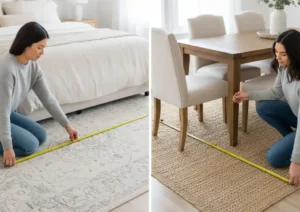Choosing the right rug size can completely transform your space. Whether you’re decorating your living room, bedroom, or dining area, rugs & carpet do more than add comfort — they define your space, balance proportions, and tie your décor together. In this guide, we’ll help you find the perfect rug size for every room in your home.

1. Why Rug Size Matters
A rug that’s too small can make your room feel disconnected, while one that’s too large can overwhelm your furniture. The right-sized rug enhances harmony and flow, giving your décor a polished, designer look. When selecting rugs & carpet, think about how they’ll interact with furniture placement, traffic areas, and the overall room shape.
2. Living Room Rug Sizes
For living rooms, the most common rug sizes are 5×8 feet, 8×10 feet, and 9×12 feet. A general rule is to have the front legs of your sofa and chairs resting on the rug while leaving some floor space visible around the edges. This layout anchors the furniture and creates a cozy conversation area.
If your living room is small, choose a rug that extends at least six inches beyond the furniture edges. For larger rooms, go with an oversized rug to keep all furniture legs on the rug for a unified look.
3. Bedroom Rug Sizes
In the bedroom, rugs & carpet add warmth and softness underfoot. For a queen bed, an 8×10 rug fits beautifully, allowing the rug to extend beyond both sides and the foot of the bed. For a king bed, a 9×12 rug gives a luxurious balance.
If you prefer smaller rugs, consider placing runner rugs or 2×6 rugs on each side of the bed for a layered and symmetrical appearance.

4. Dining Room Rug Sizes
When choosing a rug for your dining room, always ensure that the rug is large enough to fit your table and chairs — even when they’re pulled out. Typically, add 24 inches of rug space on all sides of the table.
For a 6-seat table, go with an 8×10 rug; for larger dining sets, a 9×12 rug works best. Flat-weave rugs & carpet are excellent choices here, as they’re easier to clean after meals.
5. Entryway and Hallway Rugs
Entryways benefit from runner rugs that add texture and guide guests into your home. For hallways, choose a runner that leaves 3–6 inches of flooring visible on each side. In small entryways, a 3×5 or 4×6 rug can make the space more welcoming while protecting your floors from dirt and wear.
6. Tips for Choosing the Right Rug Size
-
Measure first: Always measure your room and furniture layout before purchasing.
-
Use painter’s tape: Outline potential rug sizes on the floor to visualize the fit.
-
Consider layering: Layer smaller rugs over large neutral carpets for added depth and style.
-
Match the mood: Light-colored rugs make rooms appear larger, while dark tones add coziness.
FAQs About Choosing the Right Rug Size
1. How do I know what size rug fits my living room?
Measure the seating area and choose a rug large enough for at least the front legs of your furniture to sit on. This helps unify the space visually.
2. Should a rug go under or in front of furniture?
In most rooms, the rug should extend under the furniture’s front legs. In bedrooms or dining areas, the entire furniture piece can sit on the rug for a cohesive look.
3. What rug size works best for a small room?
For small spaces, a 5×7 or 6×9 rug usually works best. Leave a few inches of flooring visible around the rug to make the room appear larger.
4. Can I use multiple small rugs in one room?
Yes! Layering or using multiple small rugs helps define different areas in open layouts. Just ensure they complement each other in color and texture.
5. What’s the difference between rugs & carpet for room design?
Rugs are movable and versatile, ideal for layering and styling. Carpets are fixed wall-to-wall coverings that offer a permanent, uniform foundation. Combining both adds depth and warmth.
